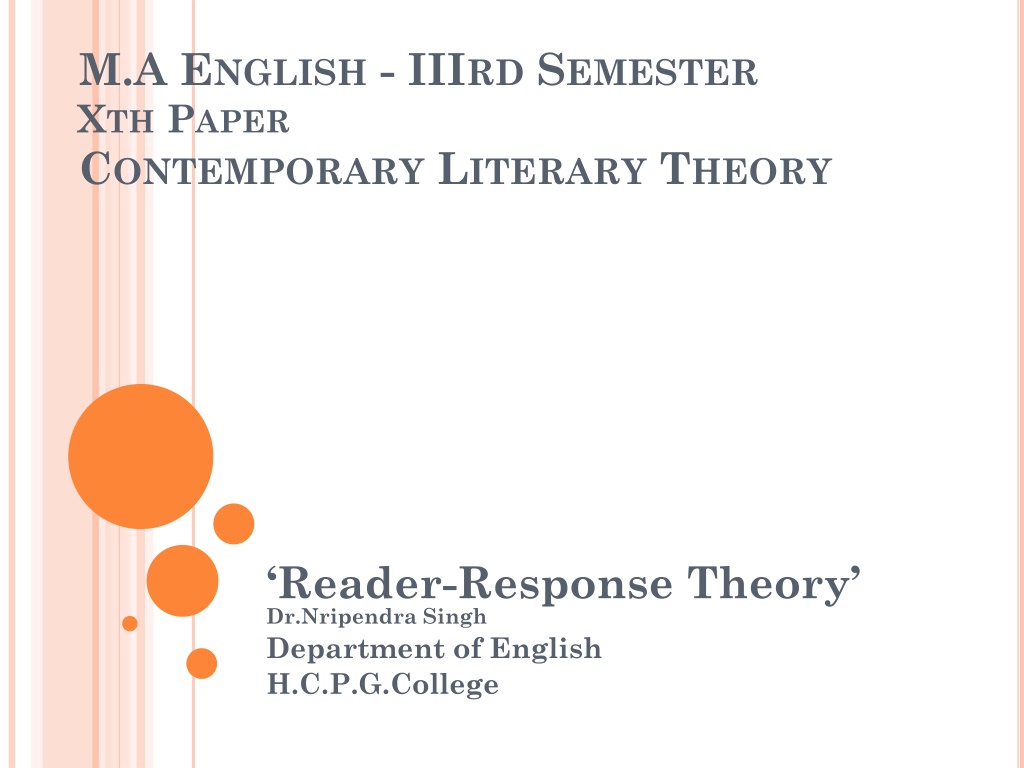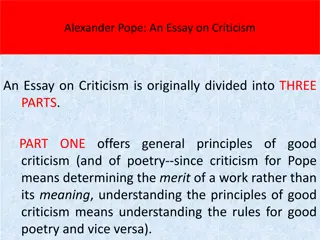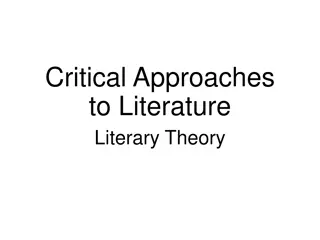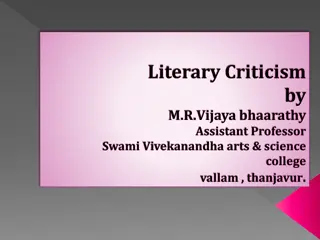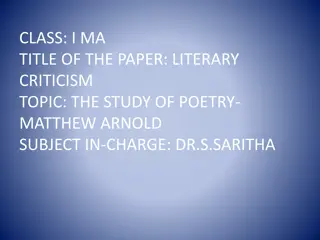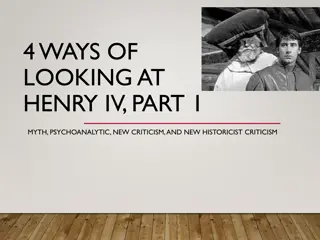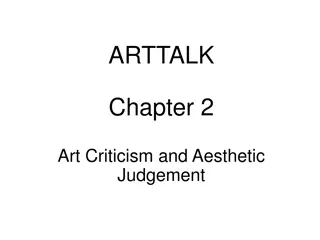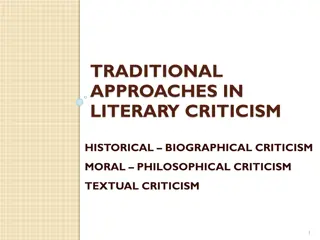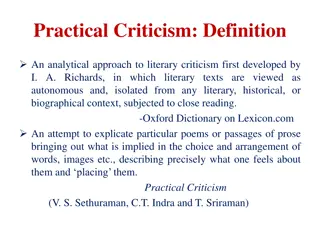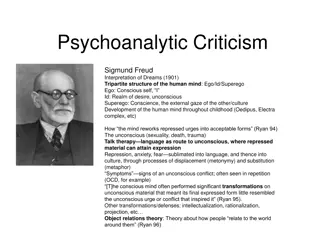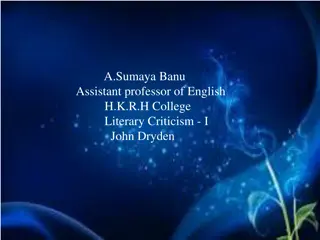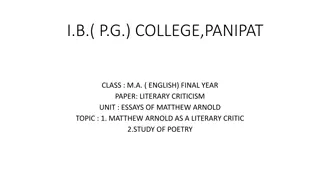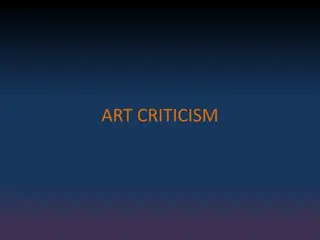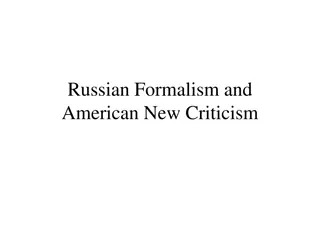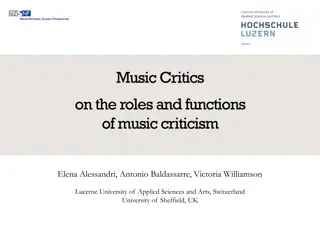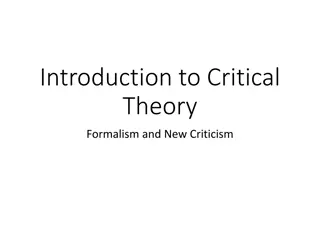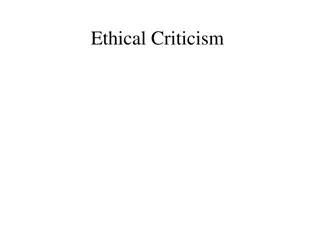Understanding Reader-Response Theory in Literary Criticism
Reader-response criticism in literary theory emphasizes the reader's role in interpreting and creating meaning from a literary work. This theory contrasts with approaches focusing solely on the author or text, highlighting the active engagement of readers in shaping the significance of a piece of literature. Scholars like Wolfgang Iser emphasize the dynamic relationship between the reader and the text, arguing that reading is a creative process that brings the work to life through individual interpretation.
Download Presentation

Please find below an Image/Link to download the presentation.
The content on the website is provided AS IS for your information and personal use only. It may not be sold, licensed, or shared on other websites without obtaining consent from the author. Download presentation by click this link. If you encounter any issues during the download, it is possible that the publisher has removed the file from their server.
E N D
Presentation Transcript
M.A ENGLISH - IIIRD SEMESTER XTH PAPER CONTEMPORARY LITERARY THEORY Reader-Response Theory Dr.Nripendra Singh Department of English H.C.P.G.College
Reader-response criticism is a school of literary theory that focuses on the reader (or audience ) and their experience of a literary work, in contrast to other schools and theories that focus attention primarily on the author or the content and form of the work. Although literary theory has long paid some attention to the reader s role in creating the meaning and experience of a literary work, modern reader-response criticism began in the 1960s and 70s, particularly in the US and Germany, in works by Norman Holland, Stanley Fish, Wolfgang Iser, Hans-Robert Jauss, Roland Barthes, and others. Reader-response theory recognizes the reader as an active agent who imparts real existence to the work and completes its meaning through interpretation. Reader-response criticism argues that literature should be viewed as a performing art in which each reader creates their own, possibly unique, text-related performance. It stands in total opposition to the theories of formalism and the New Criticism.
Reader-response suggests that the role of the reader is essential to the meaning of a text, for only in the reading experience does the literary work come alive. For example, in Mary Wollstonecraft Shelley s Frankenstein (1818), the monster doesn t exist, so to speak, until the reader reads Frankenstein and reanimates it to life, becoming a co-creator of the text. Thus, the purpose of a reading response is examining, explaining, and defending your personal reaction to a text. Negating the Formalist notion of objective reality and autotelic text that nullifies the participation of the readers, Wolfgang Iser in The Implied Reader , follows the phenomenological theories of Husserl and Ingarden, and formulates two aspects of a literary work: the artistic pole (created by the author) and the aesthetic pole (realisation accomplished by the reader), and describes reading as an active and creative process that brings the text into life by unfolding its inherently dynamic character .
In Isersview, a literary text contains a number of gaps or indeterminate elements which the reader must fill by active participation, and he observes that meaning evolves through the convergence of the text and the reader, as the active and creative reader fills the gaps or the unwritten implications by exercising his/her imagination. Iser distinguishes between the implied reader who is established by the text itself, as one who is expected to respond in specific ways to the response inviting structures of the text, and the actual reader whose responses are influenced and determined by his/her experiences, perception and background. Iser suggests that reading is a temporal and non-linear activity, a process of aesthetic recreation that is dialectic and continually interrupted by expectation, defamiliarization, contradictions, disillusion.
For Iser, a literary work is composed of both written and unwritten portions of a text. As a reader begins the reading process, the sentences that make up a work not only inform the reader of the literary movement, but produce certain expectations within the mind of the reader. However, these expectations are rarely fulfilled, as a text is full of unexpected twists and turns, and frustrations of expectations Thus whenever the flow is interrupted and we are led off in unexpected directions, the opportunity is given to us to bring into play our own faculty for establishing connections for filling in the gaps left by the text itself. These gaps are the unwritten portion of the text that calls for the reader's participation. Different readers will decide to fill in the various gaps in different ways, allowing for inexhaustible realizations of the text within its provided interpretive limits. The reader reflects on what they have read previously in the text, or if they reread the text, new light is shed on the happenings within the narrative as certain aspects of the text will assume a significance we did not attach to them on a first reading, while others will recede into the background.
In filling the gaps the readers attempt to impart consistency and coherence to the text, which, in a typical poststructuralist vein, is eternally delayed, thereby making the reader aware of the inexhausabitity of the text and its potential to generate numerous meanings, according to the interpretation of different readers. Iser further elaborates his concept of the impliedreader in The Act of Reading , in which he discusses the realreader (the actual reader whose response is documented in the text and the hypotheticalreader who is a projection of all possible realization of the text.
